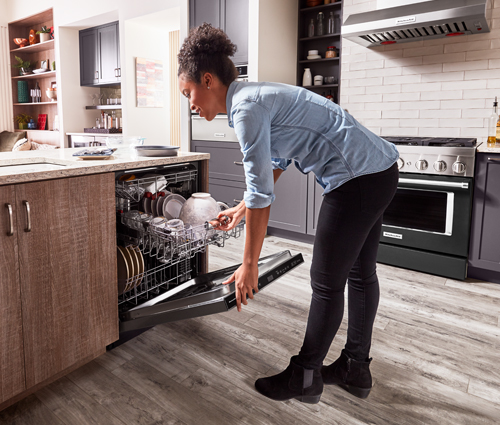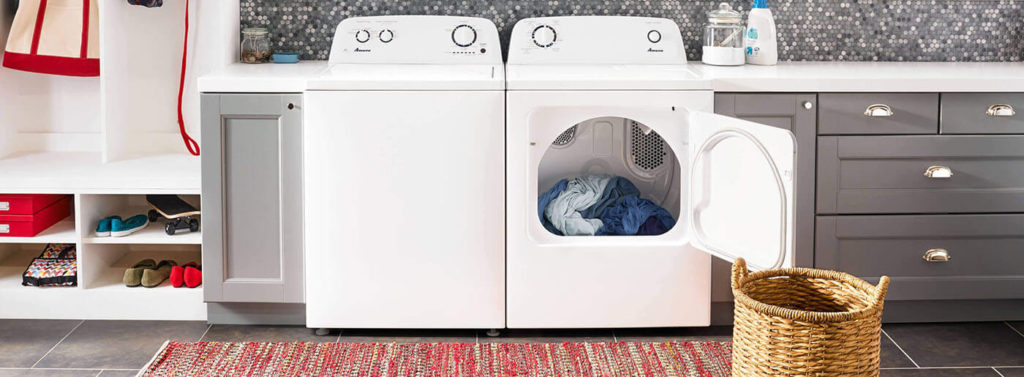It may seem challenging to install a dishwasher, but if you follow the correct plumbing and electrical requirements and read the product’s installation instructions carefully, you can do it. Regardless of whether you are replacing an old dishwasher or installing your first dishwasher, this guide provides a general outline of how to do it. Your dishwasher’s use and care guide will provide specific installation instructions, so be sure to check it throughout the installation process.
Table of contents

How to Install a Dishwasher

In order to install a dishwasher, you must drain the water and remove your old appliance (if applicable), connect water and electric lines, level your machine, and run tests to make sure it works properly. The process of installing a dishwasher for the first time could take at least two hours. If you have to remove an old dishwasher before starting the process, the process will take longer.
Dishwasher Installation Supplies

Here is what you’ll need to install a dishwasher:
- Shallow pan or bucket
- Towel or large piece of cardboard
- Flashlight
- Water line installation kit
- Power cord kit (reference your product specific install instructions)
- Wet/Dry vacuum
- Parts included with your dishwasher
- Cordless drill
- Adjustable wrench (qty 2)
- Socket wrench
- Screwdrivers
- Level
- Pliers
- Measuring tape
- Utility knife
Additional tools or supplies as listed in installation instructions.
Step-by-Step Guide

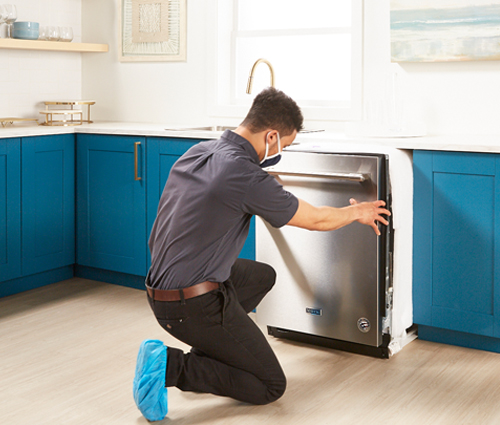
To ensure that your dishwasher fits properly in the cabinet opening, measure the cabinet opening for width, depth and height before you start installing it. It is also very important that you leave additional space for an air gap. Please refer to the space allowances set out in the installation instructions.
You will need to turn off the water supply to the dishwasher, turn off the electricity at the circuit breaker and drain any remaining water before you uninstall your current dishwasher. Upon successfully shutting off the water supply lines and electricity, unplug the dishwasher from the outlet and disconnect the drain hose and the inlet water supply hose. Disconnect the drain hose and at the hose end, remove all water with a wet/dry vacuum.
To remove the dishwasher from the countertop and cabinets, remove the screws that anchor the dishwasher to the countertop and/or cabinet sides. Remove the front access panel below the door and adjust the leveling legs in each corner with a screwdriver. Before pulling out the dishwasher from the cabinet opening, place a towel or large piece of cardboard in front of it to avoid scratching your floors. The old dishwasher must be moved out of the way before the new one is installed by sliding it onto the towel or cardboard.

You might be wondering: what do I do with my old dishwasher? Check out our helpful Guide to Removing, Disposing or Recycling Appliances.
Step 4: Prepare the New Dishwasher
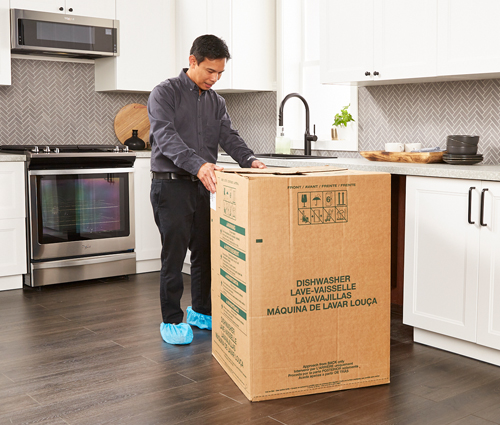
Remove the shipping materials from your appliance’s cardboard box. Ensure you follow the unpacking guide on the carton and remember to cut only within the defined lines on the carton. Take a large piece of cardboard and save it for the installation process. Remove any styrofoam or wrap from the interior of the dishwasher and set aside any parts or tools that are packaged separately.
At least one other person should help you tilt the dishwasher on its back. Remove the front access panel directly below the dishwasher door. Disconnect the tray sensors if your model has a drip tray. Connect the remaining wires as per the product manual. The drain hose should be attached to the drain port, and the power cord should be routed beneath the dishwasher’s rear legs. Follow the product manual instructions for the drain hose routing and positioning.
Pro Tip: You can use the wood runners from the dishwasher’s packaging as shims if you need to fit the appliance into a slightly wider cabinet.
The 90-degree elbow fitting should be attached to the water supply line, and the fill hose should be connected to the dishwasher’s bottom valve and tightened with pliers an additional 1/4 to 1/2 turns. Do not apply pipe thread tape or thread sealer to the plastic water valve threads. Make sure the rubber washer is present inside the water hose fitting prior to installation. Route the water supply line towards the rear of the dishwasher.
The rear leveling legs of your dishwasher should be adjusted to fit the height of the cabinet opening. Dishwashers require level placement for proper drainage of water, so use a level to check the levelness of the dishwasher front to back and side to side. The levelness can be adjusted by raising and lowering the leveling legs at the four bottom corners of the dishwasher.
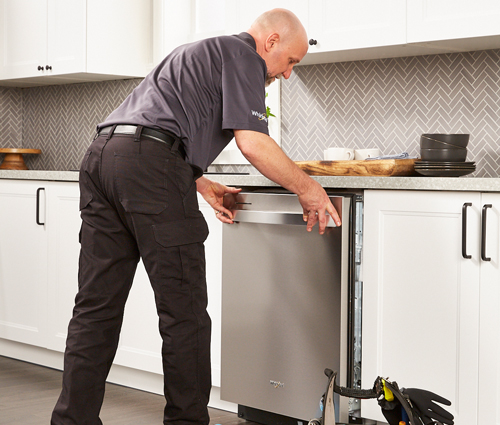
Turn the dishwasher upright on a piece of cardboard and move it to the desired location with the assistance of at least one other person. Make sure the power cord, drain hose, and water supply line are routed through the sink cabinet. The drain hose should be secured to the backside of the cabinet underneath the sink to prevent backwash. It is important that the hose arches higher than the drain inlet. The dishwasher can then be inserted into the cabinet opening by sliding it in.
Attach anchor brackets to the dishwasher collar on both the left and right sides, or to the top if mounting to a laminate or wood countertop. Slide the dishwasher back until the desired position is reached. To ensure the legs are firmly against the floor, check the level along the top edge of the dishwasher with a level and adjust the front level legs as necessary. After leveling the dishwasher, screw in the anchor brackets.
Make sure you attach the water supply line to the hot water line according to your product manual and turn on the water at the shut-off valve. Connect the drain hose to the drain port, then plug in the power cord. Connect the drip tray of the dishwasher if it has one.
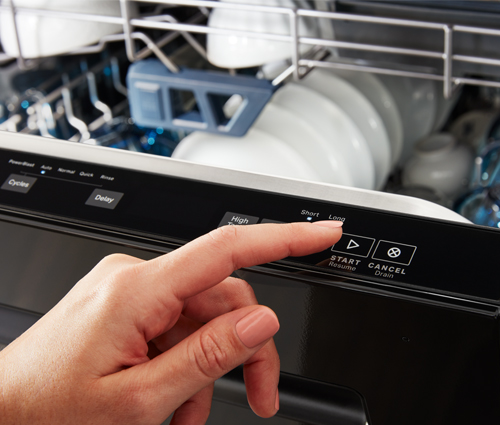
Prior to running a test cycle, make sure you remove all internal packaging from the tub. If the product has a filter, make sure the filter is fully installed.
Now you are ready to test your new dishwasher to determine if there are any leaks or other performance issues. Depending on your model, the testing instructions will differ, so consult your product’s manual for more information. You will need to attach the front access panel to the dishwasher after it has completed its test cycle, and you will also need to peel away the protective plastic lining from the dishwasher’s exterior after it has finished its test cycle.
Ready to Get Started?

